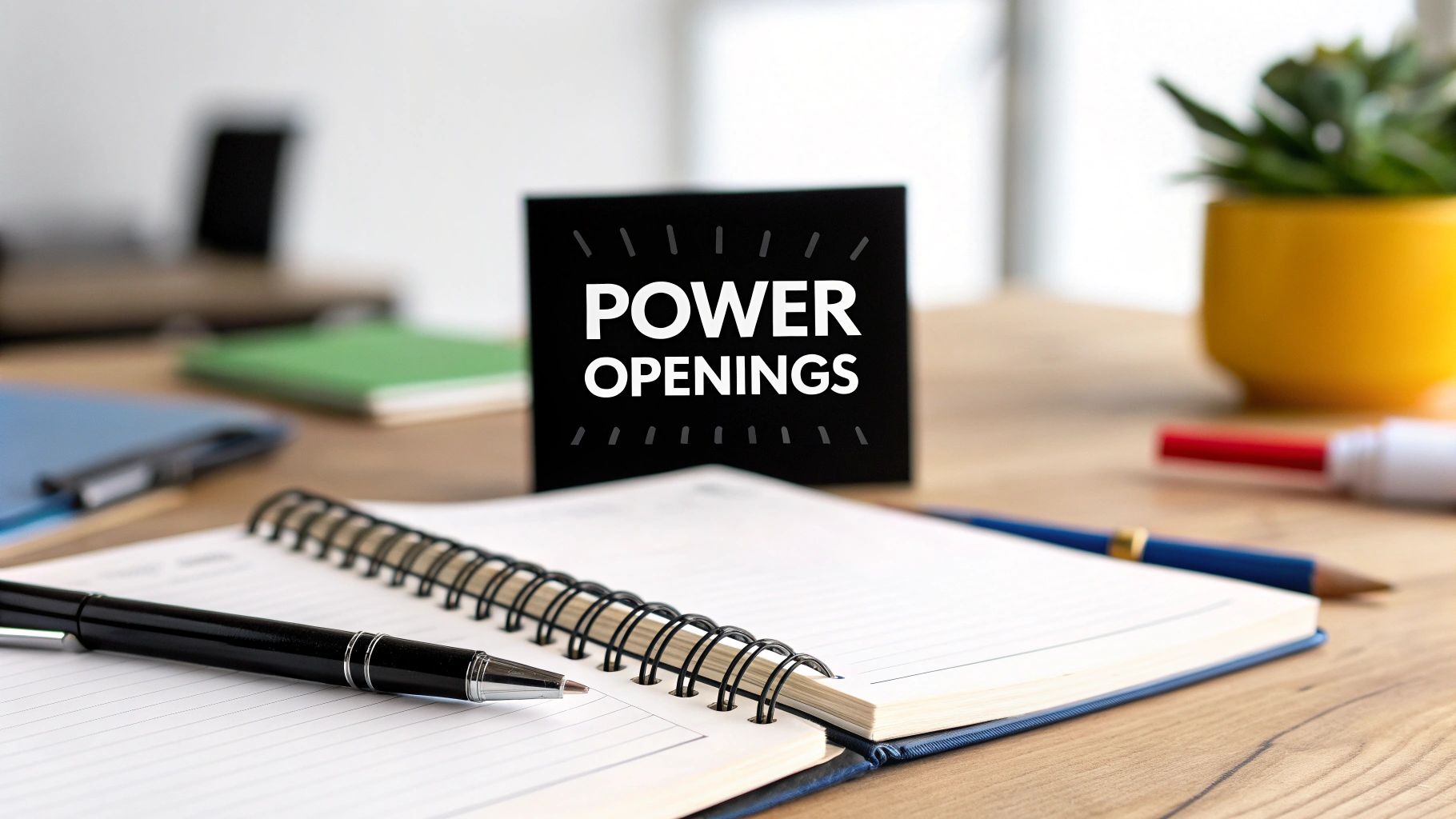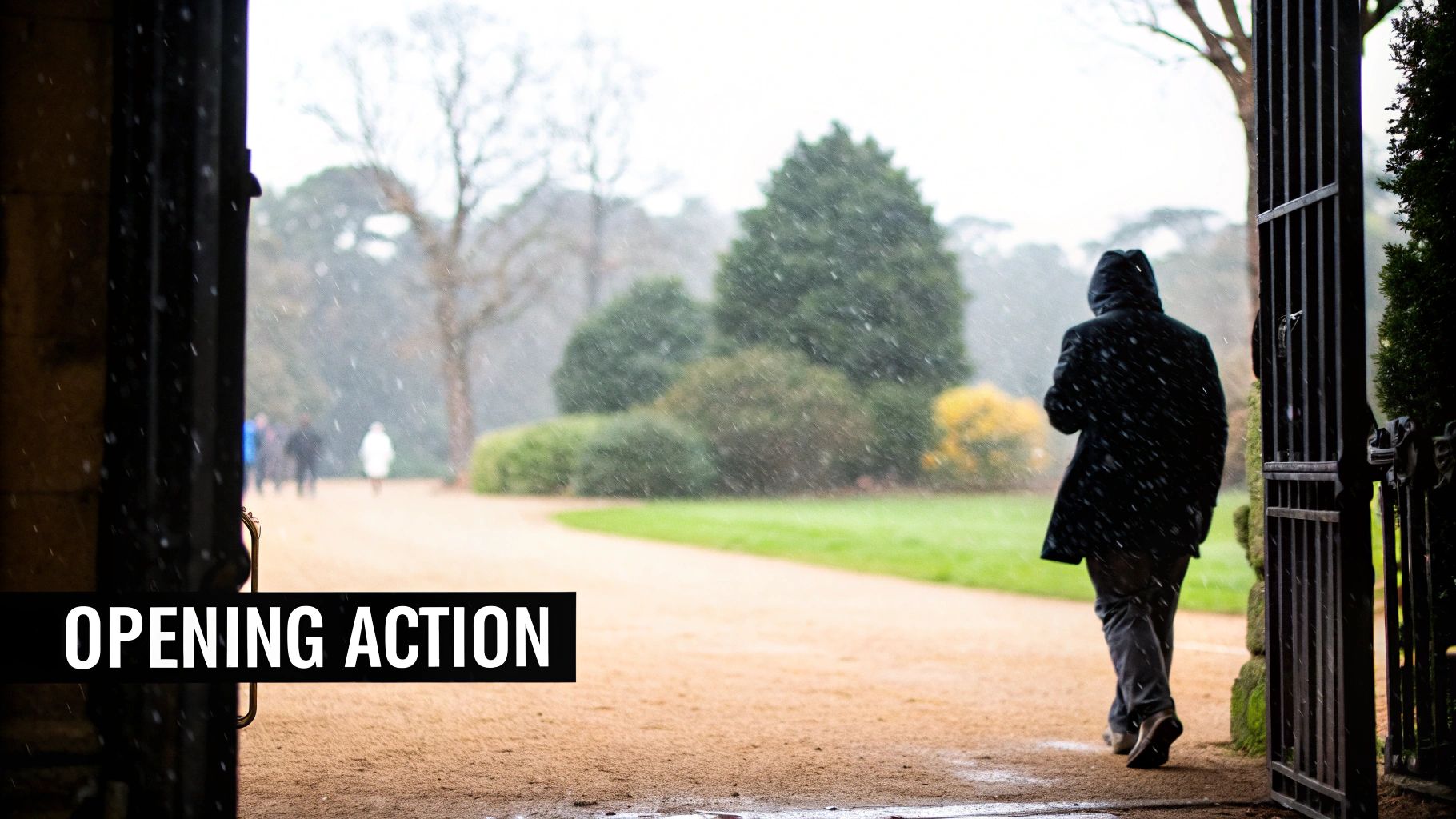
ways to begin a sentence: 10 power openings to hook readers
Published on 2025-11-11
The first few words of a sentence can make or break your content, especially on a fast-scrolling platform like LinkedIn. A strong opening grabs attention, sets the tone, and compels your audience to keep reading. While a simple subject-verb sentence is clear, relying on it too often can make your writing feel repetitive and dull.
To truly stand out in a crowded feed, you need a diverse toolkit of sentence starters. This guide explores 10 powerful ways to begin a sentence, moving beyond the basics to help you craft more dynamic, engaging, and memorable professional content. Mastering these openings is a crucial skill when you're focused on writing LinkedIn posts that get noticed.
We'll break down each technique with clear examples, actionable tips, and insights on when to use them to maximize your impact. Whether you're writing a quick update, a detailed article, or a compelling project summary, mastering these openings will transform your writing from forgettable to influential. Let's dive into the strategies that will make every word count.
1. Direct Statement/Subject-Verb Opening
This is one of the most fundamental and effective ways to begin a sentence. A direct statement places the main subject (the actor) right at the beginning, followed immediately by the verb (the action). This classic Subject-Verb-Object structure is the backbone of clear communication, delivering your core message without delay.
By leading with the who and the what, you make your point instantly understandable. This approach removes ambiguity and forces you to be concise, which is critical for grabbing attention on fast-moving platforms like LinkedIn.
How It Works
The formula is simple: Subject + Verb + ...
Instead of: "In an exciting development announced yesterday, a new species was discovered by scientists in the Amazon."
Try this: "Scientists discovered a new species in the Amazon."
Instead of: "Ahead of schedule is how our team completed the project."
Try this: "Our team completed the project ahead of schedule."
The second version in each example is stronger, clearer, and more direct. It tells the reader exactly what happened and who made it happen.
When to Use This Approach
- For clarity and impact: Use this opener for headlines, opening sentences, and key takeaways to ensure your message lands.
- In professional communication: It’s perfect for emails, reports, and instructions where precision is essential. Explore more in these 7 actionable business writing tips.
- To establish authority: Direct statements project confidence and expertise.
While powerful, avoid overusing this structure. Mix it with other sentence openers to keep your writing dynamic and engaging for your audience.
2. Participial Phrase Opening
This is one of the more sophisticated ways to begin a sentence, adding a layer of context or action before revealing the main point. A participial phrase uses a verb form ending in -ing (present participle) or -ed/-en (past participle) to act as an adjective, modifying the subject of the sentence. This technique creates a dynamic, flowing introduction to your idea.

Starting with a participial phrase immediately engages the reader by describing an action or state of being connected to your main subject. It’s an excellent way to add descriptive detail and vary your sentence structure, making your writing more memorable and professional.
How It Works
The formula is: Participial Phrase + Comma + Main Clause (Subject + Verb...)
Instead of: "The analysts studied the market trends and then made their recommendations."
Try this: "Having studied the market trends, the analysts made their recommendations."
Instead of: "The travelers were exhausted from the long journey, so they finally reached their destination."
Try this: "Exhausted from the long journey, the travelers finally reached their destination."
The revised versions connect the initial action or state directly to the subject, creating a smoother and more elegant sentence.
When to Use This Approach
- To add variety and rhythm: Use this opener to break up a series of direct statements and give your writing a more literary feel.
- For storytelling: It’s perfect for setting a scene or describing a character’s action before revealing the outcome. Learn more about how to apply these and other writing strategies with clear examples.
- To provide immediate context: It allows you to efficiently explain the "why" or "how" behind the main clause.
Be careful to avoid dangling modifiers. The phrase must clearly modify the subject that follows it, or your sentence will be confusing.
3. Prepositional Phrase Opening
This technique adds immediate context to your sentence by starting with a prepositional phrase, which is a group of words consisting of a preposition (like in, on, during, with) and its object. This approach sets the scene by establishing time, location, or relationship before you even introduce the main subject and action.
By providing this upfront context, you can create a more descriptive and engaging opening. It helps guide the reader, giving them a frame of reference that makes the main part of the sentence more impactful and easier to understand.

How It Works
The structure is: Prepositional Phrase + , + Subject + Verb + ...
Instead of: "The team launched a new campaign during the first quarter."
Try this: "During the first quarter, the team launched a new campaign."
Instead of: "A brilliant idea emerged from our brainstorming session."
Try this: "From our brainstorming session, a brilliant idea emerged."
The second version in each example draws the reader in with a contextual detail, making the core message feel more grounded and specific.
When to Use This Approach
- To add variety: Use this to break up a series of direct, subject-verb sentences and make your writing more rhythmic.
- To set the scene: It’s perfect for storytelling or descriptive writing, immediately placing your audience within a specific time or place.
- To emphasize context: When the when or where is as important as the what, lead with the prepositional phrase to give it prominence.
Keep these opening phrases concise, ideally using no more than one or two. Overloading the start of a sentence with too many phrases can confuse the reader and obscure your main point.
4. Adverbial Opening
An adverbial opening uses an adverb or adverbial phrase to set the stage before revealing the main action. This technique immediately establishes the tone, timing, or context of your statement, adding a layer of nuance that can intrigue your reader. It answers the question of how, when, where, or why before getting to the what.
By front-loading this descriptive information, you guide the reader’s interpretation from the very first word. This is one of the most effective ways to begin a sentence when you want to create a specific mood or emphasize the circumstances surrounding an event, making your point more compelling.
How It Works
The formula is straightforward: Adverb/Adverbial Phrase + , + Subject + Verb + ...
Instead of: "The data confirmed our hypothesis, which was fortunate."
Try this: "Fortunately, the data confirmed our hypothesis."
Instead of: "The market shifted without warning."
Try this: "Suddenly, the market shifted."
The second version in each example uses the adverbial opening to create immediate context and a more dynamic flow.
When to Use This Approach
- To create suspense or surprise: Openers like "Unexpectedly," or "Suddenly," grab attention.
- To guide the reader’s emotions: Using words like "Unfortunately," or "Thankfully," sets a clear emotional tone.
- To transition smoothly between ideas: Adverbs like "Consequently," or "Additionally," can effectively link sentences and paragraphs.
Use this approach sparingly to maintain its impact. Overusing it can make your writing feel repetitive, so be sure to mix it with other sentence openers for a varied and engaging rhythm.
5. Dependent Clause Opening
This technique adds sophistication and context to your writing by starting with a dependent clause. A dependent clause contains a subject and a verb but cannot stand alone as a complete sentence; it relies on an independent clause to complete its meaning. It often begins with words like although, because, if, when, or while.
By placing the conditional or contextual information first, you create anticipation for the main point. This approach is excellent for building a narrative, explaining cause and effect, or setting the scene before delivering the core message, making it a powerful way to begin a sentence with more nuance.
How It Works
The formula is: Subordinating Conjunction + Subject + Verb, ... Independent Clause.
Instead of: "She delivered a flawless presentation, although she had never performed before."
Try this: "Although she had never performed before, she delivered a flawless presentation."
Instead of: "We postponed the event because the weather forecast predicted snow."
Try this: "Because the weather forecast predicted snow, we postponed the event."
The revised versions create a logical flow, guiding the reader from a specific condition to a resulting action.
When to Use This Approach
- To show cause and effect: Lead with the "why" to make the "what" more impactful. This is perfect for explaining your reasoning in proposals or reports.
- For storytelling: Use it to set a scene or introduce a conflict at the start of a LinkedIn post or case study.
- To create sentence variety: Mix this structure with simpler openings to keep your writing engaging and prevent it from becoming monotonous.
A key rule is to always place a comma after an introductory dependent clause. Use this opener strategically to add depth and guide your reader's understanding.
6. Question Opening
Starting with a question is a powerful rhetorical tool that immediately engages your reader's mind. This approach transforms passive reading into an active mental conversation, pulling your audience directly into the topic. It creates instant curiosity and makes them want to read on to discover the answer you’re about to provide.
By posing a question, you frame the problem or topic from the reader's perspective. This technique is especially effective for grabbing attention on platforms like LinkedIn, where you need to hook your audience in the first few words.
How It Works
The formula is to ask a direct question that prompts thought: Question Word (What, How, Why, etc.) + ...?
Instead of: "Many people struggle with time management."
Try this: "Have you ever wondered why some people get so much done while others struggle?"
Instead of: "It's important to reconsider common beliefs about nutrition."
Try this: "What if everything you believed about nutrition was wrong?"
The second version in each example sparks curiosity and makes the reader an active participant, encouraging them to continue reading to find the resolution.
When to Use This Approach
- To create immediate engagement: Use a question to open a LinkedIn post, blog article, or presentation to hook your audience from the start.
- When introducing a problem: Frame a common pain point as a question to show you understand your audience's challenges.
- To challenge a common belief: A provocative question can disrupt conventional thinking and position your content as a fresh perspective. Explore more options with these examples of sentence starters.
Avoid using questions with obvious "yes" or "no" answers. The best question openers are genuine, thought-provoking, and set the stage for the valuable insights you will share next.
7. Inverted Sentence Opening
This advanced technique flips the traditional Subject-Verb-Object order on its head. An inverted sentence places the verb, object, or another part of the predicate before the subject. This deliberate reversal creates a dramatic, often poetic, effect that immediately captures attention by disrupting the reader's normal rhythm.
By deviating from the expected sentence structure, you force the reader to pause and pay closer attention. It’s one of the most powerful ways to begin a sentence when you need to emphasize a specific element or establish a unique tone right from the start.
How It Works
The formula reverses standard word order: Verb/Object/Adverbial Phrase + Subject + ...
Instead of: "The project's most significant challenges appeared only after the launch."
Try this: "Only after the launch appeared the project's most significant challenges."
Instead of: "I have never seen a more dedicated team."
Try this: "Never have I seen a more dedicated team."
The second version in each example adds a layer of sophistication and emphasis, making the statement more memorable and impactful.
When to Use This Approach
- For dramatic effect: Use it to make a bold declaration or create suspense in storytelling.
- To emphasize a condition: It’s excellent for highlighting a specific circumstance or limitation (e.g., "Only then did we understand...").
- To create stylistic variety: This approach adds a literary flair that can make your writing stand out.
Use this technique sparingly for maximum impact. Overuse can make your writing feel unnatural or overly formal. It works best when the content justifies the unusual structure.
8. Appositive Phrase Opening
This sophisticated technique adds context and detail right at the start of your sentence. An appositive phrase is a noun or noun phrase that renames or describes another noun right beside it. By placing this descriptive phrase at the beginning, you provide valuable identifying information about your subject before revealing the main action.
This is one of the more elegant ways to begin a sentence, immediately establishing credibility or context for the subject. It’s an efficient method for combining two related ideas into a single, more fluid statement, which is ideal for capturing attention in professional writing.
How It Works
The structure is: Appositive Phrase, + Subject + Verb + ...
Instead of: "Dr. Chen is a renowned neuroscientist. She revolutionized our understanding of memory."
Try this: "A renowned neuroscientist, Dr. Chen revolutionized our understanding of memory."
Instead of: "The project manager is a certified expert in Agile. He streamlined our entire workflow."
Try this: "A certified expert in Agile, the project manager streamlined our entire workflow."
The second version in each example is smoother and more professional. It connects the subject's identity directly to their action, making the sentence more impactful.
When to Use This Approach
- To introduce experts or roles: Use it to establish someone's credentials or title before describing their contribution or opinion.
- For descriptive storytelling: It helps paint a clearer picture of a person, product, or company in a compelling way.
- To add variety and rhythm: This opener breaks up the monotony of simple subject-verb sentences, adding a more literary feel to your posts.
Use this approach to add depth, but balance it with more direct sentence structures to maintain clarity and pace in your writing.
9. Absolute Phrase Opening
An absolute phrase is a sophisticated technique that adds detail and context to your entire sentence. It consists of a noun followed by a participle (an "-ing" or "-ed" verb form) and acts as an independent modifier, setting a scene or providing background information for the main clause that follows. This is one of the more literary ways to begin a sentence, perfect for adding a touch of style.
This opener creates an atmospheric, descriptive, or emotional backdrop, drawing the reader into a specific moment or condition right from the start. It’s a powerful tool for storytelling and narrative-driven content that needs to evoke a certain mood.

How It Works
The structure is Noun + Participle + ..., Main Clause. The absolute phrase modifies the entire main clause, not just a single word.
Instead of: "The project was behind schedule, and the team worked all weekend to catch up."
Try this: "The project deadline looming, the team worked all weekend to catch up."
Instead of: "I finished my coffee and finally opened the difficult email."
Try this: "My coffee finished, I finally opened the difficult email."
The second version in each example is more dynamic and descriptive, combining two related ideas into a single, more elegant sentence.
When to Use This Approach
- For storytelling: Use it to open a story-based post on LinkedIn to immediately establish the scene or emotional state.
- To add context efficiently: It provides background information without needing a separate, clunkier sentence.
- In creative or narrative writing: This is a hallmark of strong creative writing and can make your professional content feel more engaging and less robotic.
Use this technique sparingly to maintain its impact. Overusing absolute phrases can make your writing feel overly dramatic or complex.
10. Coordinating Conjunction Opening
This technique involves starting a sentence with a coordinating conjunction: for, and, nor, but, or, yet, so (often remembered by the acronym FANBOYS). While traditionally discouraged in formal writing, this modern approach creates a strong, conversational link to the previous idea, adding emphasis or a dramatic shift in tone.
Using a conjunction to open a sentence makes your writing feel more like a natural conversation. It grabs the reader by creating a brief, deliberate pause, making the statement that follows feel more significant. This is one of the most effective ways to begin a sentence when you want to create a smooth, yet impactful, transition.
How It Works
The formula is simple: Conjunction + Independent Clause
Instead of: "We analyzed the data for weeks; however, the results were inconclusive."
Try this: "We analyzed the data for weeks. But the results were inconclusive."
Instead of: "He delivered the presentation flawlessly, and in addition, he secured the client’s approval."
Try this: "He delivered the presentation flawlessly. And he secured the client’s approval."
The second version in each example feels more immediate and dynamic, breaking from rigid structure to deliver a punchier message.
When to Use This Approach
- For storytelling: Use it in LinkedIn posts or blog articles to build narrative flow and connect ideas seamlessly.
- To add emphasis: Start with "But" or "Yet" to introduce a contrasting point that demands attention.
- In marketing copy: It creates a friendly, persuasive tone that guides the reader from one thought to the next.
This is a stylistic choice best suited for less formal contexts like social media and content marketing. Use it sparingly to maintain its impact and avoid making your writing feel too casual for a professional audience.
Comparison of 10 Sentence Openings
| Opening Type | 🔄 Complexity | ⚡ Resource / Skill Required | 📊 Expected Outcome | 💡 Ideal Use Cases | ⭐ Key Advantage |
|---|---|---|---|---|---|
| Direct Statement / Subject-Verb Opening | Low — straightforward structure | ⚡ Minimal — basic grammar | 📊 High clarity and immediacy | 💡 News, instructions, technical writing, headlines | ⭐ Clear, direct communication |
| Participial Phrase Opening | Medium — comma & modifier placement | ⚡ Moderate — control of participles | 📊 Polished, descriptive context before main idea | 💡 Literary prose, features, creative passages | ⭐ Combines action + context efficiently |
| Prepositional Phrase Opening | Low–Medium — watch phrase length | ⚡ Minimal–Moderate — concise phrasing | 📊 Strong setting/time orientation | 💡 Narrative openings, travel/descriptive writing | ⭐ Quickly orients reader to scene/time |
| Adverbial Opening | Low — simple modifier start | ⚡ Minimal — careful word choice | 📊 Immediate tone, manner, or transition | 💡 Features, transitions, narrative emphasis | ⭐ Sets mood or emphasis up front |
| Dependent Clause Opening | Medium — balance clause lengths | ⚡ Moderate — clause linkage skill | 📊 Shows cause, condition, or concession clearly | 💡 Academic, explanatory, formal essays | ⭐ Clarifies logical relationships |
| Question Opening | Low — interrogative form | ⚡ Minimal — audience awareness needed | 📊 Engages curiosity and invites participation | 💡 Marketing, speeches, opinion pieces, intros | ⭐ Grabs attention and provokes thought |
| Inverted Sentence Opening | High — altered word order | ⚡ High — strong syntactic control | 📊 Dramatic emphasis and literary tone | 💡 Poetry, literary prose, memorable lines | ⭐ Produces surprise and focal emphasis |
| Appositive Phrase Opening | Medium — comma placement matters | ⚡ Moderate — noun-phrase precision | 📊 Compact identification or definition | 💡 Biographies, introductions, formal prose | ⭐ Efficiently adds identifying detail |
| Absolute Phrase Opening | Medium–High — independent modifier | ⚡ Moderate–High — participial use | 📊 Atmospheric scene or condition setting | 💡 Descriptive narrative, literary scenes | ⭐ Creates mood without subordinating clause |
| Coordinating Conjunction Opening | Low — stylistic rule-breaking | ⚡ Minimal — rhetorical judgment | 📊 Conversational, punchy rhythm and emphasis | 💡 Creative writing, journalism, ad copy | ⭐ Emphasis via deliberate informality |
Turn Your Openers into Opportunities
The ability to craft compelling sentences is a superpower in the world of professional content. Throughout this guide, we’ve explored ten distinct ways to begin a sentence, moving far beyond the simple subject-verb structure that can make writing feel flat and predictable. From the direct punch of a subject-first opening to the sophisticated flow of a participial phrase, each technique offers a unique tool for shaping your message and engaging your reader.
Mastering these openers isn't about memorizing grammatical rules; it's about understanding their strategic impact. Think of it as a toolkit for influence. A well-placed question can pull a reader in, an inverted sentence can create a dramatic pause, and starting with a dependent clause can build suspense. The true power lies in variety and intention. By consciously choosing how you begin each sentence, you control the rhythm, pace, and emotional tone of your writing, transforming a simple LinkedIn post into a memorable piece of thought leadership.
Your Path to Mastery: Actionable Next Steps
To truly integrate these techniques into your writing, you need to practice them deliberately. Here’s a simple framework to get started:
- Review and Revise: Take a recent article or post you’ve written. Read the first word of each sentence aloud. Do you hear a repetitive pattern? Challenge yourself to rewrite three to five of those sentences using different openers from this list.
- Focus on One Technique a Week: Don't try to master everything at once. This week, focus on starting more sentences with a prepositional phrase. Next week, experiment with adverbial openings. This focused approach makes the learning process manageable.
- Expand Your Structural Knowledge: As you grow more comfortable with varied sentence openers, you can take your skills to the next level. To truly elevate your prose and maintain reader interest, consider advanced sentence structures like those discussed in this guide to mastering compound and complex sentences.
The goal is to make these diverse ways to begin a sentence a natural part of your writing process. With consistent application, you will find your professional voice becoming more dynamic, authoritative, and engaging. Your ideas deserve to be presented with clarity and impact, and a powerful opening line is the first step toward ensuring your message not only lands but resonates.
Ready to create scroll-stopping content without the guesswork? autoghostwriter uses advanced AI to help you generate authentic, high-quality LinkedIn posts that incorporate these powerful sentence structures. Get proven templates and endless inspiration to make your professional voice stand out by visiting autoghostwriter today.